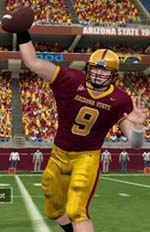It’s a debate this isn’t likely to end anytime soon, but a recent event once again stirred up questions about whether collegiate student-athletes should be paid.
Talented University of Georgia wide receiver A.J. Green violated NCAA rules by selling his game jersey from last year’s bowl game to a person the NCAA recognizes as an agent. As a result, Green has been suspended for the first four games of this season.
For those on the “pay the players” side of the argument, a column by Andy Staples of Sports Illustrated made some strong arguments that players such as Green are being exploited by their universities, apparel corporations, and the NCAA.
Green reportedly sold his jersey for less than $150, but the violation of NCAA rules cost him four of the Bulldogs’ 12 regular-season games. As Staples points out, the University of Georgia sells Green’s No. 8 jersey (see image) for between $60 and $150, of which Green receives nothing.
Staples argues that it’s a double standard that the NCAA preaches about amateurism, maintains a tax-exempt status, and then earns millions of dollars courtesy of the athletic achievements of its “student-athletes,” who are punished for the slightest overstep of the NCAA’s Britannica-like rulebook.
The sale of jerseys adorning popular players’ numbers is just a small portion of the licensing revenue the NCAA reaps from the performances of its amateur athletes. A more recent phenomenon has been the use of players’ “likenesses” in video games, which produces millions of dollars of additional revenue for the NCAA and video game creators such as EA Sports.
Some of these issues have moved into legal battles, as described in a column in the September 2009 issue of Sport Marketing Quarterly (Vol. 18, No. 3, pp. 160-164) by Anita Moorman and Marion Hambrick. In their column titled “To License or Not to License: That is the Question for Professional Sport Leagues and the NCAA,” Moorman and Hambrick describe how three recent court cases are intertwined with regard to licensing. Two of those cases directly involve the NCAA.
In Keller v. Electronic Arts, Inc., former football player Sam Keller filed a lawsuit against EA Sports, the NCAA, and the Collegiate Licensing Company (CLC) for the video game maker’s use of players’ likenesses, mannerisms, and distinctive appearances without the players’ permission. In O’Bannon v. NCAA, former basketball player Ed O’Bannon filed a lawsuit against the NCAA and CLC on behalf of himself and former student-athletes, who he claims, since their eligibility has expired, should no longer be bound to the amateur status form (Form 08-3a) that the NCAA requires all student-athletes to sign.
“As these cases wind their way through the legal system, the NCAA must revisit the delicate balance it has achieved between preserving amateurism, and avoiding exploitation and over-commercialization of student-athletes and maintaining its vital revenue-producing activities, including licensing student-athletes’ names, image, likeness, or other aspects of identity.” (p. 163)
While there is currently no clear-cut answer to the question of whether collegiate athletes should be paid, things are slowly trending toward the point in time when deeper discussions among decision makers must take place.



 Posted by mattbrann
Posted by mattbrann 
 Mark Nagel and Richard Southall, co-authors of the forthcoming second edition of Sport Facility Management: Organizing Events and Mitigating Risks, published by
Mark Nagel and Richard Southall, co-authors of the forthcoming second edition of Sport Facility Management: Organizing Events and Mitigating Risks, published by 